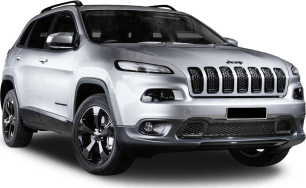I covered about 400km in total, on sealed surfaces in between off-road testing and overall the Tank 300 was rather impressive.
It’s quiet and refined on-road but has few alarming characteristics, which I’ll get to soon.
The petrol engine is lively and punches this 2106kg wagon along at a nice clip.
Steering has a sporty weight to it and is precise enough for easy driving in the city, suburbs and on the highway.
Ride and handling is nicely composed – mostly. It feels a bit floaty at times, some body-roll creeps in during livelier turns and there is a spongy feel to the coil-spring suspension.
But, other than that, this 4WD consistently feels stable and planted.
NVH (noise, vibration and harshness) levels are kept to a minimum, though there’s some wind rush around the chunky wing mirrors.
Visibility is reasonable but a bit pinched in places. The big bonnet can impact the driver’s forward vision, and that’s why, when you’re 4WDing, the Tank 300’s transparent chassis function comes in handy.
As for those 'alarming characteristics' I mentioned earlier…
Under heavy braking the Tank 300 pitches forward severely, with seemingly all momentum forcing the vehicle into a disconcerting nose-dive. Not good.
Driver-assist tech is generally seamless, but lane keep assist is too harsh and too pre-emptive in its application – wrenching you into line whenever it ‘thinks' you have drifted too far off-centre.
Auto stop-start engages abruptly and there is a disconcerting amount of lag before the vehicle starts again from standstill.
Not good at all when you need quick off-the-mark pace to safely merge with traffic from a stop light or after a lengthy pause at a roundabout.
The Tank 300 did however prove to be an effective off-roader. It handled the gravel track to our 4WD test site with ease.
This route is peppered with light corrugations, as well as, deeper into the bush, severe ruts and potholes, so it’s not an easy drive for any standard 4WD.
But this GWM wagon in 4WD high-range, did well, and was only ever rattled (a bit) when we hit a section of much deeper wheel ruts and potholes where modified 4WDs had damaged the track.
My patented ‘Watch out for that 'roo!' emergency-braking test again revealed the Tank 300’s tendency to pitch forward dramatically under heavy braking and it took some work to keep the vehicle on track.
The Tank 300 is well suited to low-range 4WDing. It may not have a ton of torque on tap (380Nm), but that pulling power is available across a decent rev range and this 4WD makes efficient use of what it does have.
Its off-road driving modes, including 'Mud/Sand', 'Rock', 'Mountain' and 'Pothole', seem calibrated appropriately for the demands of different terrain, although I wouldn’t rely on them, too much.
In the middle of an Aussie summer I didn’t get to test the ‘Snow’ setting, but when you engage some of the modes it will lock diffs where appropriate.
Low-range gearing is sound, without being Jeep Wrangler Rubicon great, and with its front and rear diffs locked, the Tank 300 tackled every 4WD challenge with ease.
Visibility is restricted in places due to the cabin build style, but that’s not such an issue when you’re 4WDing at very low speeds – you can always stop and get out of the vehicle to check the track ahead.
However, the Tank 300’s 'Transparent Chassis' function goes some of the way to improving driver visibility.
This system is similar to the 'Transparent Bonnet' view in the Land Rover Defender in that its aim is to extend the range of the around-view camera to include a view under the Tank 300 (represented on-screen as a ‘ghost vehicle’ outline when Transparent Chassis is selected).
Wheel travel is decent enough – the Tank 300 has a live rear axle – but the standard Michelin Primacy SUV tyres (265/60 R18) are not well suited to 4WDing. Fit a decent set of aggressive all-terrains to make this 4WD wagon even better off-road.
The Tank 300 loses a few off-road efficacy points, though, because…
It feels low. Ground clearance is listed as 224mm, and it has official approach and departure angles of 33 and 34 degrees, respectively (no ramp-over angle is listed), but it feels vulnerable to scraping its undercarriage on the earth.
Its pronounced side steps also seem to nudge the ground when you’re traversing rough terrain. Not among the Tank 300’s best features.
Listed payload is 446kg, which will quickly be used up once you add aftermarket equipment, passengers, camping gear and your dogs to the mix.
Unbraked towing capacity is listed as 750kg, while braked capacity is 2500kg.








.png)












































.png)























 copy.png)
















